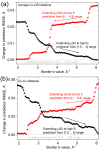Improving sensitivity of XANES structural fit to the bridged metal-metal coordination
- PMID: 38530834
- PMCID: PMC11075727
- DOI: 10.1107/S1600577524002091
Improving sensitivity of XANES structural fit to the bridged metal-metal coordination
Abstract
Hard X-ray absorption spectroscopy is a valuable in situ probe for non-destructive diagnostics of metal sites. The low-energy interval of a spectrum (XANES) contains information about the metal oxidation state, ligand type, symmetry and distances in the first coordination shell but shows almost no dependency on the bridged metal-metal bond length. The higher-energy interval (EXAFS), on the contrary, is more sensitive to the coordination numbers and can decouple the contribution from distances in different coordination shells. Supervised machine-learning methods can combine information from different intervals of a spectrum; however, computational approaches for the near-edge region of the spectrum and higher energies are different. This work aims to keep all benefits of XANES and extend its sensitivity towards the interatomic distances in the first and second coordination shells. Using a binuclear bridged copper complex as a case study and cross-validation analysis as a quantitative tool it is shown that the first 170 eV above the edge are already sufficient to balance the contributions of Cu-O/N scattering and Cu-Cu scattering. As a more general outcome this work highlights the trivial but often overlooked importance of using `longer' energy intervals of XANES for structural refinement and machine-learning predictions. The first 200 eV above the absorption edge still do not require parametrization of Debye-Waller damping and can be calculated within full multiple scattering or finite difference approximations with only moderately increased computational costs.
Keywords: EXAFS; XANES; improved hypercube sampling; machine learning; radial basis functions; vibrational spectroscopy.
open access.
Figures






References
-
- Adhikary, C. & Koner, S. (2010). Coord. Chem. Rev. 254, 2933–2958.
-
- Arunadevi, A. & Raman, N. (2020). J. Coord. Chem. 73, 2095–2116.
-
- Benfatto, M. & Longa, S. D. (2009). J. Phys. Conf. Ser. 190, 012031.
-
- Borfecchia, E., Beato, P., Svelle, S., Olsbye, U., Lamberti, C. & Bordiga, S. (2018). Chem. Soc. Rev. 47, 8097–8133. - PubMed
Grants and funding
LinkOut - more resources
Full Text Sources
Research Materials

